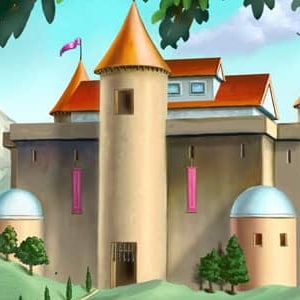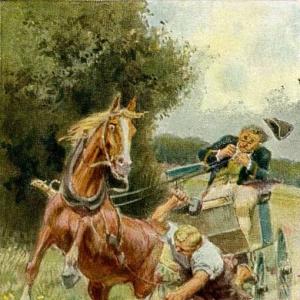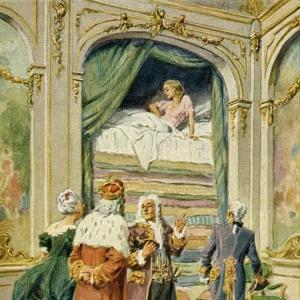Reading time: 5 min
A poor peasant-boy one day heard the priest say in church that whosoever desired to enter into the kingdom of heaven must always go straight onward. So he set out, and walked continually straight onwards over hill and valley without ever turning aside. At length his way led him into a great town, and into the midst of a church, where just at that time God’s service was being performed. Now when he beheld all the magnificence of this, he thought he had reached heaven, sat down, and rejoiced with his whole heart. When the service was over, and the clerk bade him go out, he replied, „No, I will not go out again, I am glad to be in heaven at last.“ So the clerk went to the priest, and told him that there was a child in the church who would not go out again, because he believed he was in heaven. The priest said, „If he believes that, we will leave him inside.“ So he went to him, and asked if he had any inclination to work. „Yes,“ the little fellow replied, „I am accustomed to work, but I will not go out of heaven again.“ So he stayed in the church, and when he saw how the people came and knelt and prayed to Our Lady with the blessed child Jesus which was carved in wood, he thought „that is the good God,“ and said, „Dear God, how thin you are! The people must certainly let you starve; but every day I will give you half my dinner.“ From this time forth, he every day took half his dinner to the image, and the image began to enjoy the food. When a few weeks had gone by, people remarked that the image was growing larger and stout and strong, and wondered much. The priest also could not understand it, but stayed in the church, and followed the little boy about, and then he saw how he shared his food with the Virgin Mary, and how she accepted it. After some time the boy became ill, and for eight days could not leave his bed; but as soon as he could get up again, the first thing he did was to take his food to Our Lady. The priest followed him, and heard him say, „Dear God, do not take it amiss that I have not brought you anything for such a long time, for I have been ill and could not get up.“ Then the image answered him and said, „I have seen thy good-will, and that is enough for me. Next Sunday thou shalt go with me to the wedding.“ The boy rejoiced at this, and repeated it to the priest, who begged him to go and ask the image if he, too, might be permitted to go. „No,“ answered the image, „thou alone.“ The priest wished to prepare him first, and give him the holy communion and the child was willing, and next Sunday, when the host came to him, he fell down and died, and was at the eternal wedding.
 Learn languages. Double-tap on a word.Learn languages in context with Childstories.org and Deepl.com.
Learn languages. Double-tap on a word.Learn languages in context with Childstories.org and Deepl.com.Backgrounds
Interpretations
Adaptions
Summary
Linguistics
„The Heavenly Wedding“ is a fairy tale collected by the Brothers Grimm, two German scholars and cultural researchers, Jacob and Wilhelm Grimm. They are best known for their collection of German and European folktales, which they compiled and published as „Grimm’s Fairy Tales“ (originally titled „Children’s and Household Tales“ or „Kinder- und Hausmärchen“) in 1812.
The Brothers Grimm collected these stories from various sources, such as oral traditions, written manuscripts, and other storytellers. Their goal was to preserve the cultural heritage and history of the German people, which was at risk of being lost due to rapid industrialization and urbanization. The collection includes well-known stories like „Cinderella,“ „Snow White,“ „Rapunzel,“ and „Hansel and Gretel,“ as well as lesser-known tales like „The Heavenly Wedding.“
The Grimm brothers‘ collection of fairy tales has become an essential part of the Western literary canon and has influenced countless authors, artists, and filmmakers. The tales often contain elements of magic, symbolism, and moral lessons that have resonated with audiences across generations.
„The Heavenly Wedding,“ like many other Grimm fairy tales, incorporates themes of faith, love, devotion, and the power of intention. The story also touches upon the importance of the church as a sanctuary for spiritual growth and the transience of earthly life. The fairy tale serves as a reminder to prioritize spiritual values and connections, reflecting the religious and cultural context of the time in which it was collected.
„The Heavenly Wedding“ can be interpreted on multiple levels, reflecting various themes and messages:
Faith and Innocence: The boy’s pure and unwavering faith leads him to believe that he has found heaven on Earth. His innocence allows him to see the divine in the church and the carved image, fostering a strong connection with the divine.
Devotion and Generosity: The boy’s selflessness in sharing his food with the image of the Virgin Mary and Jesus exemplifies devotion and generosity. His actions bring about a miracle, as the image grows larger and stronger, showing that acts of kindness and love can have a powerful impact.
The Power of Intention: The boy’s actions are driven by his genuine desire to care for what he believes to be the divine. His good intentions are acknowledged by the image, demonstrating that sincerity and good will are valuable spiritual qualities.
The Transience of Earthly Life: The boy’s death at the end of the story reminds readers that life is temporary and that the ultimate goal is to join the eternal heavenly wedding. His readiness to leave the earthly realm symbolizes the importance of prioritizing spiritual growth and connection to the divine.
The Role of the Church: The church serves as both a literal and metaphorical space for the boy’s spiritual journey. It provides a sanctuary where he can connect with the divine and fulfill his mission of devotion and generosity.
In summary, „The Heavenly Wedding“ highlights the themes of faith, innocence, devotion, generosity, the power of intention, the transience of life, and the role of the church in one’s spiritual journey. The story encourages readers to cultivate these virtues and seek a deeper connection with the divine.
„The Heavenly Wedding“ has inspired many adaptations and retellings in various forms of media. Here are a few notable adaptations:
„The Invisible Prince“ by Mary Jane Beaufrand: This young adult novel is a modern retelling of „The Heavenly Wedding.“ The story follows a teenage girl who falls in love with an invisible prince and must navigate the challenges of their relationship.
„The Glass Mountain“ by Diana Wynne Jones: This novel for young readers is a retelling of „The Princess on the Glass Hill,“ which is a similar fairy tale to „The Heavenly Wedding.“ The story follows a young man who must climb a glass mountain to win the hand of a princess who is guarded by an invisible being.
„Cinderella“ (2015 film): This live-action adaptation of the classic fairy tale features a scene in which the fairy godmother turns Cinderella’s pumpkin into a carriage and her mice into horses. This scene is reminiscent of the transformation of the young woman in „The Heavenly Wedding“ into a goddess or a fairy after the wedding.
„East of the Sun and West of the Moon“ by Jackie Morris: This children’s book is a retelling of a Norwegian folktale that shares many similarities with „The Heavenly Wedding.“ The story follows a young woman who must journey to a distant land to rescue her true love, who is held captive by an invisible troll.
„Barbie in the 12 Dancing Princesses“ (2006 film): This animated film for children features a scene in which the twelve princesses are transported to a magical world where they dance with invisible princes. This scene is reminiscent of the invisible wedding in „The Heavenly Wedding.“
Overall, „The Heavenly Wedding“ has inspired numerous adaptations and retellings, demonstrating the enduring appeal of this timeless fairy tale.
„The Heavenly Wedding“ is a fairy tale by the Brothers Grimm, which tells the story of a poor peasant boy who, after hearing a priest say that the way to enter the kingdom of heaven is to always go straight onward, sets out on a journey. He walks continually without turning aside, eventually reaching a grand church in a large town. Believing he has arrived in heaven, the boy decides to stay and is allowed to do so by the priest, who is impressed by the boy’s faith.
The boy is diligent in his work at the church and, when he notices a wooden carving of the Virgin Mary with the baby Jesus, he believes it to be the „good God“ and vows to share his meals with the figure. As he feeds the image daily, it begins to grow larger and stronger, which astonishes the townspeople and the priest. Curious, the priest observes the boy and discovers that he is sharing his food with the image, which seems to accept it.
When the boy falls ill for eight days, he is unable to bring food to the image. Once recovered, he resumes his offerings, apologizing to the image for his absence. The image speaks to the boy, expressing gratitude for his good intentions and inviting him to the heavenly wedding on the following Sunday. The boy excitedly shares the news with the priest, who requests to attend the wedding as well but is denied by the image.
Prepared for the wedding with holy communion, the boy receives the host and, in that moment, dies. Thus, his soul joins the eternal wedding in heaven. The tale emphasizes faith, devotion, and the transformative power of love and kindness.
The Brothers Grimm fairy tale „The Heavenly Wedding“ is rich with themes and motifs that are characteristic of their tales, making it an interesting piece for linguistic and thematic analysis.
Narrative Structure and Journey Motif: The story follows a classic fairy tale structure, beginning with a simple premise: the boy hears the priest’s words and sets out on a literal journey towards heaven. This journey motif is common in fairy tales, symbolizing a quest for enlightenment or fulfillment. The directive to „always go straight onward“ establishes the journey as one of moral and spiritual significance. It’s a metaphor for leading a righteous life, with the destination (heaven) symbolizing ultimate spiritual reward.
Characterization: The protagonist is described as a „poor peasant-boy,“ which immediately evokes sympathy from the audience and situates his goodness in contrast to his humble beginnings. This character is typical of Grimm’s tales, where the innocents or underprivileged often attain great spiritual or moral victories. The boy’s innocence and literal interpretation of spiritual teachings drive the narrative, highlighting themes of faith and simplicity.
Symbolism: The church setting represents the intersection between the earthly and the divine. The boy’s perception of it as heaven underscores themes of innocence and belief. The act of sharing food with the wooden image of the Virgin Mary emphasizes themes of faith, devotion, and kindness. The miraculous change in the statue correlates to spiritual growth and divine interaction.
Dialogue and Divine Communication: The dialogue between the boy and the image adds a layer of the supernatural. The image speaking back is a divine acknowledgment of the boy’s pure intentions. The conversations are simple, highlighting the boy’s innocence and sincerity, contrasting with the more complex religious interpretations that adults might construct.
Themes of Death and Eternal Life: The conclusion of the tale, where the boy dies to attend the „eternal wedding,“ touches on themes of death as a transition to a higher state of being. The wedding can be interpreted as a metaphor for the union with the divine or the soul’s ultimate reward.
Moral and Religious Undertones: The tale carries a moral message about the value of sincerity, faith, and charitable acts. It illustrates a belief that divine understanding values the intention and heart behind actions, rather than the actions themselves. The story also suggests that spiritual rewards may not be perceived or understood by others, as reflected in the priest’s role and denial to join the heavenly wedding.
Overall, „The Heavenly Wedding“ is a tale that intertwines simple, childlike faith with profound religious and existential themes, leveraging the fairy tale form to explore ideas of innocence, devotion, and divine reward. The story invites readers to reflect on the nature of spiritual journeys and the ultimate rewards they promise.
Information for scientific analysis
Fairy tale statistics | Value |
|---|---|
| Number | KHM 209 |
| Aarne-Thompson-Uther-Index | ATU Typ 767 |
| Translations | DE, EN |
| Readability Index by Björnsson | 33.8 |
| Flesch-Reading-Ease Index | 76.1 |
| Flesch–Kincaid Grade-Level | 8.8 |
| Gunning Fog Index | 11.2 |
| Coleman–Liau Index | 7.1 |
| SMOG Index | 8.4 |
| Automated Readability Index | 9.3 |
| Character Count | 2.639 |
| Letter Count | 2.020 |
| Sentence Count | 21 |
| Word Count | 519 |
| Average Words per Sentence | 24,71 |
| Words with more than 6 letters | 47 |
| Percentage of long words | 9.1% |
| Number of Syllables | 648 |
| Average Syllables per Word | 1,25 |
| Words with three Syllables | 17 |
| Percentage Words with three Syllables | 3.3% |

 Facebook
Facebook  Whatsapp
Whatsapp  Messenger
Messenger  Telegram
Telegram Reddit
Reddit















